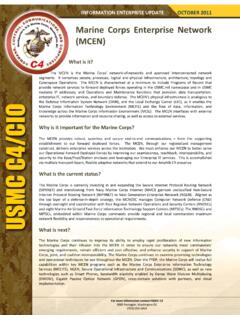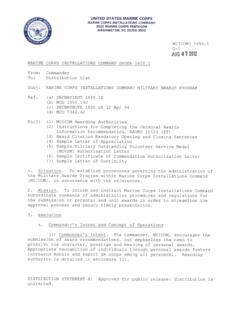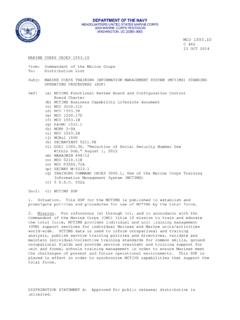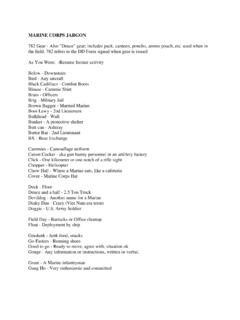Transcription of THE PATH TO BECOMING A MARINE CORPS AVIATOR
1 THE PATH TO BECOMING A MARINE CORPS AVIATOR Every journey starts with a first step. Your first step in making a decision to join the ranks of the elite starts here. By reviewing the information in this pamphlet, you'll be able to discuss options with the Officer Selection Officer and gain an understanding of not only what the MARINE CORPS can offer you, but what we expect of you as well. The specific training path you will follow depends on where you are in your college education, your qualifications, and your preferences. The following highlights the opportunities and career patterns for MARINE Aviators. Use this information package in conjunction with the PLC or OCC information package in order to fully understand the Aviation program and the unlimited benefits and opportunities that this affords you. To find out more, contact Captain Kozel at 814-237-8578. How can I fly with the MARINE CORPS ?
2 If your dream is to be a pilot, the MARINE CORPS can guarantee flight training as early as your Freshman year in college. $$$$$ As a MARINE CORPS Pilot, you will receive AVIATOR pay, in addition to your regular salary. Flight pay begins at $150 per month and increases incrementally to $650 per month after 6 years of service ($7,800 annually). Flight bonuses of $12,000 were given to aviators in 1996. Nearly 30% of MARINE CORPS Officers are pilots. The Platoon Leaders Class -- Aviation option guarantees qualified students that they will attend flight training to fly for the MARINE CORPS upon graduation from college and The Basic School. College Freshman-Juniors. The PLC--Aviation option give you a chance to graduate with a commission and real flying experience, well before your military flight training begins. After you have successfully completed all pre-commissioning training, you can receive all-expense-paid, FAA-approved flight instruction.
3 This is exciting, valuable training in itself, and just a taste of what you will experience as a MARINE CORPS AVIATOR : MARINE CORPS Flight Orientation Program (MCFOP) will introduce students who have some interest in flying to a MARINE CORPS Pilot and allow them to fly together in civilian aircraft. This can help you find out if you might enjoy BECOMING a pilot and have your questions answered by a MARINE CORPS Pilot. Speak with an Officer Selection Officer to see when and where the next MCFOP flight is scheduled. MARINE CORPS Flight Indoctrination Program (MCFIP) provides civilian flight instruction to fully trained members of the Platoon Leaders Class -- Aviation option who have agreed to accept their commission. Students who have completed their summer training and are within one year of graduation are eligible for this program. If you qualify, the MARINE CORPS Officer Programs (Platoon Leaders Class and Officer Candidates Course) can GUARANTEE you a position as a pilot!
4 These are the ONLY undergraduate and graduate programs that will guarantee you a position as a MARINE CORPS Pilot! These positions are open to men AND women, are very competitive in nature and fill up quickly. Contact us immediately to see if you initially qualify for available pilot slots. MARINE AVIATION The MARINE CORPS may not be the largest service, but it makes up in innovation what it lacks in size. Its openness to new ideas helped the MARINE CORPS quickly recognize the potential of the airplane. As early as World War I, marines were involved in air-to-air combat, antisubmarine bombing, land bombing, and aerial resupply. During the 1920s MARINE pilots serving in Haiti, the Dominican Republic, and Nicaragua began coordinating with ground units. Close air support skills were honed by serving as scouts, strafing hostile positions, and dropping in one mission. But it was during World War II that MARINE aviation came of age.
5 Close air support was widely used on Guadalcanal in 1942 to support ground combat operations. MARINE pilots initially flew from aircraft carriers and later moved ashore to Henderson Field. They often provided the only source of fire support. Amphibious warfare and close air support have been defining features of the MARINE CORPS ever since. The MARINE CORPS has its own tactical aircraft that support its ground forces in protecting interests worldwide. MARINE CORPS aviation is an important part of the MARINE CORPS air-ground task force. The air and ground elements work together as one unit to achieve the mission. In playing its part in an amphibious assault, MARINE aviation is expected to do a laundry list of jobs. These include air reconnaissance, anti-war warfare, assault support, offensive air support, electronic warfare, and control of aircraft and missiles. MARINE AVIATION CAPABILITIES OFFENSIVE AIR SUPPORT MISSIONS - Provide close and deep air support for the landing force.
6 - Attack and destroy enemy installations, equipment, supplies, and personnel within the area being attacked. - Assist in the destruction of ground, air, and surface targets outside the area being attacked. ANTI-AIR WARFARE MISSIONS - Attack and destroy enemy aircraft and defensive weapons before they are launched, and neutralize enemy airfields, radar installations, defense weapons systems, and air support areas. - Extend the task force's anti-air warfare inland in order to gain and maintain air superiority. - Provide air defense for the force beachhead. - Minimize the effect of enemy air. ASSAULT SUPPORT MISSIONS - Provide vertical assault lift capability for the landing force. - Provide fixed-wing assault lift for high-priority cargo and personnel into the assault area. - Deliver critical materials to combat units using whatever aircraft are available. - Evacuate units or individuals as needed. - Provide in-flight refueling for either fixed-wing or rotary-wing aircraft.
7 AIR RECONNAISSANCE MISSIONS - Use photographic, multi-sensor imagery, electronic, and visual reconnaissance to meet the requirements of the landing force. ELECTRONIC WARFARE MISSIONS - Search for, intercept, locate, and identify radiated electromagnetic energy. - Prevent or reduce the enemy's use of electromagnetic energy. - Ensure friendly effective use of the electromagnetic spectrum. PIPELINE FOR MARINE CORPSPILOTSS trike/JET TS39 weeks156 hrs T-45 ANAS Kingsville,TX21-28 weeks92 hrs TA-4jNAS Meridian, MSStrike/JET24-35 weeks100 hrs T-2 CNAS Meridian, MS20-30 weeks67 hours T-34 CNAS Corpus Christi, TX NAS Whiting Field, FL6 weeks196 academic hrsNAS Pensacola, FL22 weeks116 hrs TH-57 B/CNAS Whiting Field, FLMulti-Engine/C-13026 hrs T-34C NAS Corpus Christi,TXNAS Whiting Field, FL20 weeks88 hrs T-44 NAS Corpus Christi, TXHelicopter26 hrs T-34C NAS Corpus Christi,TXNAS Whiting Field, FL20-30 weeks67 hours T-34 CVance AFB6 weeks196 academic hrsVance AFB, TX AVIATION PRE-INDOCTRINATION (API) Aviation Pre-Indoctrination is the initial training that Student Naval Aviators receive prior to commencing actual flight training.
8 Aviation Pre-Indoctrination is conducted at Naval Air Station Pensacola, Florida, and lasts six weeks. The first three weeks are devoted to studying Aerodynamics, Aviation Physiology, Engines, and Navigation. The material is presented through programmed texts supplemented with lectures and films. The fourth and fifth weeks are devoted to sea and land survival. Sea survival consists of class work and practical application in the Pensacola Bay. Instruction is given on survival equipment, release mechanisms, and survival techniques. Land survival follows with classroom and fieldwork in techniques of food procurement, map reading, and shelter building. Upon completion of Aviation Pre-Indoctrination, Student Naval Aviators report to Naval Air Station Whiting Field to begin Primary Flight Training. PRIMARY FLIGHT TRAINING Primary Flight Training is conducted at Naval Air Station Whiting Field in Milton, Florida.
9 Milton is located approximately 30 miles north of NAS Pensacola. While at Whiting, you will be assigned to one of the three Primary Training Squadrons. Lieutenants begin their flight training in the T-34C, a high-performance training airplane. The syllabus consists of 67 flight hours in the T-34C, supplemented with 27 hours of synthetic trainer timer and 166 hours of flight support lectures and academics. The flight syllabus includes Familiarization, Instruments, Night Flying, Precision Aerobatics, and Formation training. Highlights of the flight syllabus are four solo flights, including two solo aerobatic flights. All Student Naval Aviators start in the T-34. Toward the end of Primary, you are selected for one of the three different advance pipelines (Jets, Helicopters, and Turbo-Props). Selection is based on your grades, personal desires, and the needs of the MARINE CORPS .
10 Once Primary Flight Training is completed and aircraft type is selected, you begin Intermediate Flight Training for Helicopters and Turbo-Props, or Basic Jet Training Squadron. INTERMEDIATE FLIGHT TRAINING If you have selected Helicopters or Turbo-Props you stay in your Primary Training Squadron for another six weeks. During this time you receive 26 more hours in the T-34, concentrating in Radio Instruments and IFR/VFR Navigation. Ground school, academic training, and simulator flights ensure that each Student Naval AVIATOR is well versed in Flight Rules and Regulations prior to reporting for Advanced Training. ADVANCED TURBO-PROP TRAINING Once you have satisfactorily completed Intermediate Flight Training in the T-34, you report to Naval Air Station Corpus Christi, Texas, to begin Advanced Training in multi-engine aircraft. Over a 20-week period, you will receive 88 flight hours in the T-44 Beech Queen Air.







